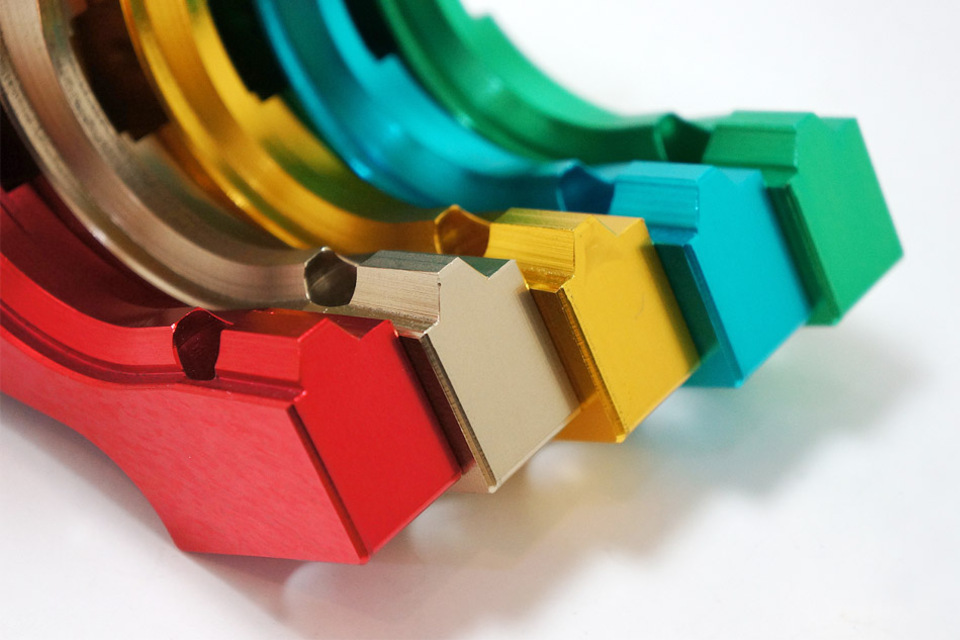You're probably familiar with the term 'anodizing,'but do you know how powerful it can be when it comes to enhancing your electronic products?
Anodizing is a process that enhances the appearance, durability, and lifespan of metal or alloys. By applying an electrochemical process on the surface of metals and alloys, they are transformed into beautiful works of art.
Not only does this give your electronics a unique look and feel, but it also makes them more reliable and durable. In this article, we'll explore the power of anodizing and how it can help improve your electronics.
Overview of Anodizing
Anodizing not only enhances the look and feel of electronic products, but it also provides powerful protection for them!
Anodizing is an electrochemical process that forms a durable and corrosion-resistant oxide layer on the surface of metals like aluminum, magnesium, and titanium. This layer helps protect against oxidation, abrasion, wear, and corrosion. It also provides insulation from electricity.
Anodized surfaces are resistant to weathering and fading over time due to their protective coating. By providing these essential properties to your electronics, anodizing ensures they'll last longer and remain more visually attractive for years to come—allowing you to create a product that stands out in a crowd while still being reliable enough for daily use.
How Anodizing Enhances Electronic Products

You can see the benefits of coating your electronic products with anodizing -- a process that boosts durability and performance. Anodizing with aluminum oxide provides a range of advantages for electronic devices, including:
- Increased resistance to corrosion and wear while maintaining lightweight properties
- Better adhesion for decorations and color treatments
- Durability even under extreme environmental conditions
- Improved electrical insulation for increased safety when handling electronics
When you choose anodizing, your electronics will be protected from the harshest elements, ensuring maximum longevity and performance as well as a sleek finish that will impress all who use it. These qualities make anodizing the perfect choice for those who want to stand out from the crowd and feel like their electronics are part of them.
Plus, with its low-maintenance upkeep requirements, anodizing is sure to save you time and money in the long run!
Process of Anodizing
The process of anodizing begins with preparing the surface to be treated. This includes cleaning and etching, which helps ensure a uniform finish.
Once the surface is properly prepared, it's time for anodizing. This involves passing electric current through the metal in an electrolyte solution.
Finally, sealing is performed to protect the surface from corrosion and wear.
Preparation
Before anodizing, you must carefully prepare the surface of your electronic product. Cleaning and pre-treatment processes are essential for successful anodizing, as they remove any contaminants that could cause problems down the line. Depending on the material, a variety of techniques can be used to clean it – from simple soap-and-water scrubbing to more complex chemical treatments.
Once your piece is cleaned, it's important to apply a protective coating that will help prevent oxidation during the anodizing process. These steps ensure that once you've completed the anodizing process, your electronic product will have a durable finish that looks great and won't corrode over time.
Anodizing requires patience and attention to detail – but with a bit of practice, anyone can do it! By spending time preparing your piece beforehand, you'll set yourself up for success in creating a beautiful finish for your electronic product. You'll also be able to take pride in having done something special with your own two hands – making something unique and personal for yourself or someone else that wouldn't have been possible without the power of anodization!
Anodizing

Anodizing is like giving an ordinary object a coat of armor, protecting it from the wear and tear of time while also enhancing its beauty.
It's a process used to create a protective film on metal surfaces, typically aluminum or titanium. Anodizing involves electrochemically oxidizing the surface of the metal which causes its natural properties to be improved.
This makes it possible for metals to resist corrosion and wear better than before, as well as making them look more attractive by creating bright colors that are durable and long-lasting.
Anodizing can also help increase electrical insulation properties, which makes it perfect for electronic products where reliability is key. From your cell phone's casing to your laptop's keyboard – anodizing adds an extra layer of protection in even the most demanding situations.
With its ability to protect against everyday wear-and-tear while still looking good, it's no wonder that anodizing has become so popular among those who want their electronics to last longer!
Sealing
Sealing is the process of adding a protective barrier to surfaces, often metal, that have already been anodized. This helps to protect the material and preserve its color, as well as making it more resistant to corrosion. It also makes it easier to keep clean and maintain its appearance over time.
When sealing anodized materials, it's important to use the correct sealant for the specific material being used. Different materials will require different types of sealants in order to ensure maximum protection and longevity. For example, aluminum may need an epoxy-based sealant while steel may need a silicone-based one.
Additionally, careful attention must be paid to temperature control when sealing anodized metals since this can affect how effective the sealant is at protecting the surface from damage or discoloration over time. By utilizing sealing techniques after anodizing, electronic products can be better protected against wear and tear while maintaining their attractive aesthetic qualities.
Types of Anodizing
Discover how anodizing can make your electronic products look and perform better with the two different types available.
Anodizing is a process of introducing a thin oxide layer to metal surfaces by electrolysis, which creates a protective seal that helps protect against corrosion and wear. It's also incredibly versatile, as there are two different types -- chromic and sulfuric -- that offer different benefits depending on the desired outcome.
Chromic anodizing provides an extremely hard finish that resists corrosion and is ideal for electronics components that require frequent use or need to be resistant to harsh conditions. On the other hand, sulfuric anodizing produces thicker oxide layers, which makes it well-suited for parts where strength is needed for heavier loads. Plus, this type of finish has excellent lubricity characteristics that reduce friction on moving parts and help keep them running smoothly.
Whether you're looking for a strong finish or something more decorative, anodizing can provide the perfect solution to enhance your electronic product's performance and aesthetics.
Factors to Consider When Anodizing
Now that you've got a solid understanding of the different types of anodizing, let's explore the factors to consider when deciding which type of anodizing is best for your electronics. Anodizing can be a great way to enhance any product and make it look unique, but there are several important things to remember before making a decision.
Here are some key points to think about:
- Quality:
- How long will the finish last?
- Is the coating thick enough?
- Will it offer protection from corrosion?
- Aesthetics:
- What color options are available?
- Does it provide an even finish?
- How well does it reflect light?
- Cost:
- What's the cost associated with each type of anodizing process?
- Is there price variation based on size and quantity?
Taking these factors into consideration can help ensure that you choose the right type of anodizing for your product. If done correctly, using one or more types of anodizing can add a beautiful finish as well as provide protection from corrosion and other environmental elements. Anodizing is a great way to give your hardware products an extra boost in quality and style.
Cost-Effectiveness of Anodizing

Anodizing can be a cost-effective way to improve the look and longevity of your hardware, as long as you consider the upfront costs. For example, a case study has demonstrated that anodizing aluminum components for a large piece of machinery increased their lifespan by up to 10%, saving the company money in the long run.
It's easy to see why anodizing is so popular with companies looking to extend their hardware's life and maintain its aesthetic appeal. Anodized metals are also more resistant to corrosion and wear compared to untreated metals. This means that you won't need to replace your metal components as often, which could save you even more money over time.
Anodizing can provide significant savings for any business or individual looking for ways to maximize their investment in hardware.
Safety Considerations
When investing in anodizing, safety should always be top of mind. Anodizing is a process that requires special expertise and knowledge to ensure that it's done safely and correctly. Therefore, it's important to choose a reputable anodizer who has the qualifications and experience necessary to do the job right.
Ensure all safety procedures are followed at all times and verify that all protective equipment is up-to-date and in good working order.
Safety considerations for anodizing can make or break your project. Utilizing a qualified professional with the right experience will help you to avoid costly mistakes and ensure your product meets industry standards.
Taking the time to research the best options available will pay off in the long run as you'll have confidence in knowing your product was created with safety in mind.
Environmental Impact of Anodizing
Making the decision to anodize can have a huge environmental impact. Anodizing is a process that uses electricity to create an oxidized coating on aluminum, which makes it more durable and increases its resistance to corrosion.
The downside is that anodizing involves large amounts of water, which can be difficult to dispose of in a way that does not harm the environment. Additionally, some of the chemicals used in the process can be toxic if they're not disposed of properly. There is also the potential for air pollution from gases released during production.
However, despite these potential negative impacts, anodizing still offers many benefits when done correctly and responsibly. It helps reduce energy consumption by decreasing wear and tear on metal surfaces over time, thus reducing waste in landfills and conserving resources used in manufacturing processes.
It also enhances product performance by providing protection against corrosion without adding extra weight or bulkiness. This means less energy usage overall due to lighter products with better durability and longer life spans.
Ultimately, considering all factors involved in production and disposal of materials used for anodization should help ensure a positive environmental outcome when done responsibly.
Conclusion
You've seen the power of anodizing in enhancing electronic products. It's cost-effective, safe, and doesn't leave a negative environmental impact.
In fact, recent studies estimate that anodizing can reduce manufacturing costs by up to 30%. That savings alone is enough to make any business consider utilizing this process for their electronic products.
Anodizing is a great way to boost your product's quality while still staying within budget. So don't hesitate - take advantage of the many benefits anodizing has to offer and give your electronic products the edge they need!
